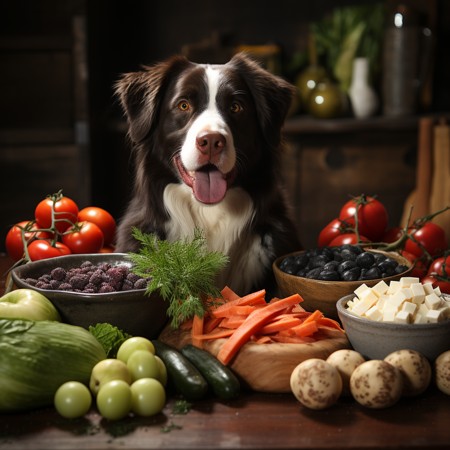A Bone of Contention
The raw food diet for dogs, also known as the BARF (Biologically Appropriate Raw Food) diet, has been a topic of much debate among pet owners and veterinarians. Some swear by its benefits, claiming it leads to shinier coats, healthier skin, and higher energy levels. However, others caution against potential risks, including exposure to harmful bacteria and nutritional imbalance. This guide aims to provide a balanced view on the subject, helping you make an informed decision for your beloved pet.
The Raw Deal: What is a Raw Food Diet?
A raw food diet for dogs typically includes a combination of raw meat, bones, fruits, vegetables, and dairy products. Proponents of this diet argue that it closely mimics the natural eating habits of dogs' wild ancestors, thus promoting optimal health and longevity.
Companies like Embark, Wisdom Panel, Orivet, 5Strands, and DNA My Dog offer a variety of tests that can help pet owners understand their dogs' unique genetic makeup, breed mix, and potential health risks. This information can be invaluable when deciding on the best diet for your dog.
The Good, the Bad, and the Raw: Pros and Cons of a Raw Food Diet
The Bright Side: Potential Benefits of a Raw Food Diet
Advocates of the raw food diet often highlight the following benefits:
- Improved Coat and Skin Health: Many pet owners report that their dogs have shinier coats and healthier skin when fed a raw diet. This is often attributed to the higher fat content and natural oils present in raw meat.
- Enhanced Digestive Health: Raw diets are often easier for dogs to digest as they are less processed than commercial dog foods. This can lead to better nutrient absorption and smaller, less smelly stools.
- Increased Energy Levels: Some pet owners notice an increase in their dogs' energy levels and overall vitality when switched to a raw diet.
- Better Dental Health: Chewing on raw bones can help clean a dog's teeth and promote better dental health.
However, it's important to note that while these benefits are often cited by proponents of the raw food diet, they are largely based on anecdotal evidence. Scientific research on the benefits of raw diets for dogs is currently limited and more studies are needed to substantiate these claims.
Understand safe and unsafe foods for dogs with our Comprehensive Guide to Safe and Unsafe Foods for Dogs.

The Other Side of the Coin: Potential Risks of a Raw Food Diet
While a raw food diet may have potential benefits, it's crucial to consider the potential risks as well. These include:
- Nutritional Imbalance: Preparing a nutritionally balanced diet for your dog can be challenging. Raw diets, if not properly formulated, can lead to deficiencies or excesses of certain nutrients, which can have serious health consequences.
- Risk of Infection: Raw meat can be a source of harmful bacteria such as Salmonella and Listeria, which can cause illness in both dogs and humans. According to a study, nearly 25% of raw food samples tested positive for harmful bacteria.
- Bone-related Injuries: While chewing on bones can potentially improve dental health, it can also lead to injuries. Dogs can break their teeth, or ingest bone fragments that can cause choking or damage to the digestive tract.
- Cost and Time: Preparing a raw food diet can be more expensive and time-consuming than feeding commercial dog food.
Given these potential risks, it's essential to consult with a veterinarian or a pet nutrition expert before switching your dog to a raw food diet.
Learn about the role of diet in preventing and managing canine obesity in our article Canine Obesity: The Power of Diet for Prevention and Management.
Making the Switch: Transitioning to a Raw Food Diet
If you decide to transition your dog to a raw food diet, it's important to do so gradually. A sudden change in diet can cause digestive upset in dogs. Start by introducing small amounts of raw food into your dog's regular diet, gradually increasing the proportion of raw food over a period of weeks.
Remember, every dog is unique and what works for one might not work for another. Regular check-ups and nutritional testing can help ensure that your dog's diet is meeting their nutritional needs. Companies like Embark, Wisdom Panel, Orivet, 5Strands, and DNA My Dog offer tests that can provide valuable insights into your dog's nutritional needs.
A Bone to Pick: Controversies Surrounding the Raw Food Diet
The raw food diet for dogs is not without controversy. Many veterinarians and pet nutrition experts express concerns about the potential risks associated with raw diets. The American Veterinary Medical Association (AVMA) discourages the feeding of raw or undercooked animal-source protein to dogs due to the risk of illness to the pet as well as to people living in the household.
Moreover, many animal care facilities such as animal hospitals and kennels do not accept animals fed raw food diets due to the potential for disease spread. It's important to consider these factors when deciding on the best diet for your dog.
The Final Scoop: Is a Raw Food Diet Right for Your Dog?
The decision to feed your dog a raw food diet is a personal one that should be made based on careful consideration of the potential benefits and risks. It's important to consult with a veterinarian or a pet nutrition expert to ensure that your dog's nutritional needs are being met and that they are not at risk of infection or other health issues.
Get a comprehensive understanding of different types of dog food in our Ultimate Guide to Dog Food: Dry, Wet, and Raw Explained.
Remember, at ThePetPicks.com, we believe in providing comprehensive, reliable, and accurate information to help you make the best decisions for your furry friend. Because they're not just pets, they're family.
FAQs
What is a raw food diet for dogs?
A raw food diet for dogs, also known as the BARF (Biologically Appropriate Raw Food) diet, typically includes a combination of raw meat, bones, fruits, vegetables, and dairy products.
What are the potential benefits of a raw food diet for dogs?
Potential benefits of a raw food diet for dogs include improved coat and skin health, enhanced digestive health, increased energy levels, and better dental health. However, these benefits are largely based on anecdotal evidence and more research is needed.
What are the potential risks of a raw food diet for dogs?
Potential risks of a raw food diet for dogs include nutritional imbalance, risk of infection, bone-related injuries, and the cost and time involved in preparing the diet.
How can I transition my dog to a raw food diet?
If you decide to transition your dog to a raw food diet, it's important to do so gradually to avoid digestive upset. Start by introducing small amounts of raw food into your dog's regular diet, gradually increasing the proportion of raw food over a period of weeks.
Should I consult with a veterinarian before switching my dog to a raw food diet?
Yes, it's essential to consult with a veterinarian or a pet nutrition expert before switching your dog to a raw food diet. They can provide guidance on how to ensure that the diet is nutritionally balanced and safe for your dog.
Are there any tests that can help me understand my dog's nutritional needs?
Yes, companies like Embark, Wisdom Panel, Orivet, 5Strands, and DNA My Dog offer a variety of tests that can provide valuable insights into your dog's unique genetic makeup, breed mix, potential health risks, and nutritional needs.
What should I do if my dog gets sick after switching to a raw food diet?
If your dog gets sick after switching to a raw food diet, it's important to consult with a veterinarian immediately. Symptoms such as vomiting, diarrhea, lethargy, or loss of appetite could indicate a serious issue and should not be ignored.
Can all dogs be fed a raw food diet?
While some dogs may thrive on a raw food diet, it's not suitable for all dogs. Puppies, senior dogs, dogs with certain health conditions, and dogs with compromised immune systems may not be suitable candidates for a raw food diet. Always consult with a veterinarian before making significant changes to your dog's diet.
Is a raw food diet more expensive than commercial dog food?
The cost of a raw food diet can vary widely depending on factors such as the quality of the ingredients used, where you live, and whether you prepare the food yourself or purchase pre-made raw meals. In general, a raw food diet can be more expensive than commercial dog food.
Can I feed my dog a combination of raw food and commercial dog food?
Yes, some pet owners choose to feed their dogs a combination of raw food and commercial dog food. This can be a way to provide some of the potential benefits of a raw diet while mitigating some of the risks. However, it's important to ensure that the overall diet is nutritionally balanced. Consult with a veterinarian or a pet nutrition expert for guidance.
Final Note
This guide is intended to provide a comprehensive overview of the raw food diet for dogs, including its potential benefits and risks. However, every dog is unique, and what works for one dog may not work for another. Always consult with a veterinarian or a pet nutrition expert before making significant changes to your dog's diet. At ThePetPicks.com, we're here to help you make the best decisions for your furry friend. Because they're not just pets, they're family.

